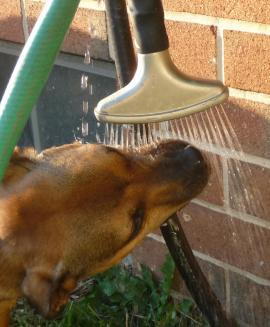Summer Hazards For Pets
- posted: Jun. 20, 2016
 Summer Hazards
Summer Hazards
The official start of summer has finally come to York, but with it can come some dangers to pets that everyone should be aware of. Besides leaving a pet in a hot car (see Patton Veterinary Hospital’s upcoming summer newsletter for more on this), the number one concern on hot summer days are heat related issues like dehydration, sunburn and heat stroke.
Dogs and cats cannot sweat, so they must lose excess heat by panting. In extreme heat, dogs may not be able to keep up with heat loss, and can quickly become overheated. Cats are less prone to heat stroke, but can still become overheated in extreme temperatures. Dogs with thick coats and dogs and cats with short noses known as brachycephalic breeds such as pugs and Persian cats are at higher risk of heat stroke, but any pet can be affected. Heat stroke can cause excessive panting or difficulty breathing, drooling, weakness and collapse. Heat stroke is serious and can be fatal.
Prevent heat stroke by keeping pets indoors during the most intense heat of the day. If they must be outside, make sure they have access to shade and plenty of water. Exercise pets early in the morning or late in the evening when it is cooler. If your pet seems to be experiencing signs of heat stroke, call your vet immediately and begin measures to cool your pet. Get the dog or cat into a cool/lukewarm bath (NOT an ice bath) or wet him with a hose. If using a hose, make sure the water is cool—garden hoses can get hot in the sun, and the water can heat up causing scalding and burns. Transport your pet to the vet in an air conditioned car or with all windows down. Your vet will monitor your pet’s temperature, and will most likely provide IV fluid support.
Bee stings area another common summer injury. While most dogs and cats will experience only minor reactions to bee stings such as redness, swelling, or hives, occasionally, pets may have a serious allergic reaction to bee stings just as some people do. If your pet has a minor reaction removing the stinger if present, a dose of Benadryl and monitoring may be all that is needed. If your pet has significant facial swelling or seems to be having difficulty breathing or collapses, seek veterinary care.
One hazard that many people may not think about is a picnic favorite—corn on the cob. Dogs that ingest discarded corn cobs can have significant problems, and sadly Patton Veterinary Hospital sees a few cases each year. Corn cobs are cylindrical and are not digestible. They are often just small enough to pass out of the stomach, but are just the right size and shape to get stuck in the intestine. This blocks the intestine and can cause significant damage to the bowel. Dogs with corn cob foreign bodies (or any intestinal foreign body) will usually have a poor appetite, vomiting, and may have diarrhea or lack of bowel movement. This can be life threatening, and surgical removal of the stuck cob is necessary, so, seek veterinary care right away if you know or suspect your dog may have eaten a corn cob and never, ever give corn cobs to your dog to chew.
Please keep these hazards in mind so you and your pets can have a safe and happy summer!
This blog brought to you by the Patton Veterinary Hospital serving Red Lion, York and the surrounding communities.
Location
Patton Veterinary Hospital
425 E Broadway
Red Lion, PA 17356
